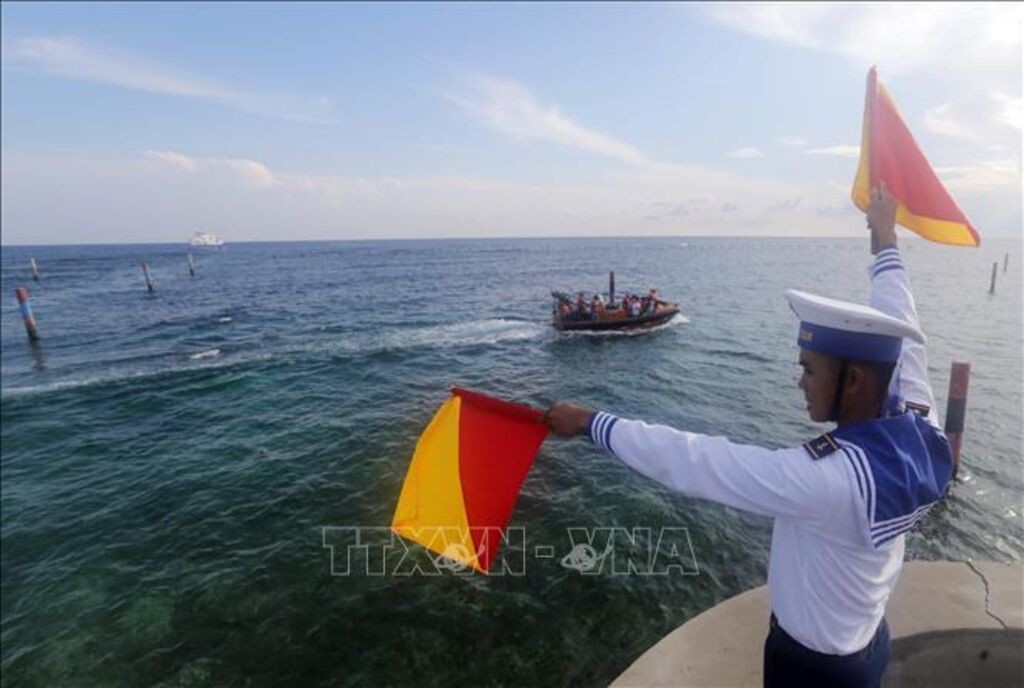
Determination to protect the Fatherland's sovereignty over the sea and islands (article 3):
Vietnam's indisputable sovereignty over Paracel and Spratly Islands
Latest
 |
| Images of the flag-raising ceremony on Truong Sa island. |
According to international law, there have existed 5 basic methods of acquiring territory: (i) effective occupation, (ii) prescription; (iii) accretion; (iv) cession and (v) annexation.
Vietnam exercise continuous and undisputed state power
Historical evidences shown that the State of Vietnam has effectively occupied the Spratly and Paracel Islands at least since the 17th century, prior to the publication of Do Ba’s map in 1868. Therefore, the State of Vietnam used the method of acquiring territory through effective occupation to acquire the Spratly and Paracel Islands. This was in line with principles listed in the Socialist Republic of Vietnam’s White Paper.
In fact, the State exercised its ownership of the Spratly and Paracel Islands through various activities such as organizing exploitation, surveying, placing stele, building temples, plating trees, protecting fishermen, etc, as well as demonstrating its will through authorizing the actions of local authorities with strict regulations on rewards and punishments. It also fulfilled its obligations in ensuring safety by international maritime navigation, rescuing victims, etc. The State of Vietnam fully met the standards of acquiring ownerless territory since its acquirement of the two Islands.
 |
| A soldier performing his duties as a navigator, helping a canoe travelling to Da Lat island, Truong Sa archipelago. (Source: VNA) |
Thus, the principle of continuous and peaceful exercise of state power creating sovereignty have been accepted in international norms in resolving territorial disputes. Therefore, Vietnam can apply this principle in the case of Paracel and Spratly Islands. In history, through its Hoang Sa and Bac Hai fleet, the State of Vietnam continuously and peacefully exercise its power with the two Islands, therefore established its sovereignty over Paracel and Spratly Islands.
The factor of proximity in territorial acquisition
However, some countries turned to the basis of geographical proximity to claim its sovereignty over the two Islands. Nevertheless, regarding practical international norms, there is no such document or term mentioning that a coastal state has the claim of sovereignty over islands of close proximity to its coastline. In fact, even though an island may lie in close proximity to a coastal state, its sovereignty can still belong to another states. Customary international law and principles of modern international law have stated that a country’s claim of sovereignty over territories lie in its process of establishing sovereignty through the exercise of state power, instead of relying on geographical proximity.
| Vietnam’s attempts to maintain peace, stability and development in the East Sea are of great significance in the region. By supporting a rules-based order and diplomatic initiatives, Vietnam has helped shape the discourse surrounding disputes and highlighted the importance of international law in resolving conflicts. The country’s commitment to peaceful and cooperative solutions has earned respect from the international community and strengthened its diplomatic position. |
For example, Jersey, Guernsey, Alderney and Shark Island are located closer to France than the UK, but their sovereignty in fact belong to the UK. Phu Quoc Island lies closer to the coast of Cambodia, but its sovereignty belongs to the State of Vietnam. The development of modern international law and international maritime law, up to the establishment of UNCLOS 1982, did not mention the advantages of geographical distance of a state in claiming sovereignty over territories such as islands, banks and shoals. Therefore, it is normal to see that a coastal state may or may not have sovereignty over an island in spite of the close geographical proximity.
Vietnam as the sole provider of sufficient historical evidences
Regarding the process of State establishing sovereignty with Paracel and Spratly Islands, only Vietnam had sufficient historical evidences, in accordance to international law, regarding establishing sovereignty with such territories.
Legal evidences in history, archaeology, law and sea culture have clearly proved that in the beginning of the 17th century, when the Nguyen lords established its sovereignty through the exercise of state power with the Paracel and Spratly Islands, no other regional and international country had claimed its sovereignty through the exercise of state power in such islands.
Therefore, Vietnam’s sovereignty of the Paracel and Spratly Islands are undeniable.









